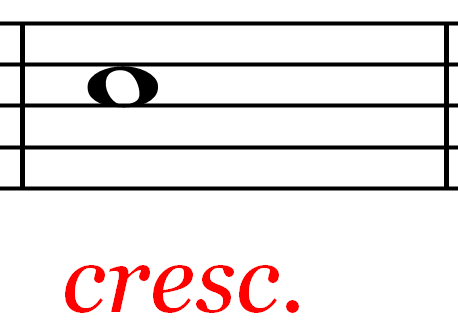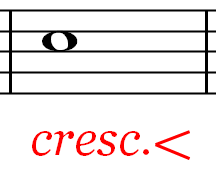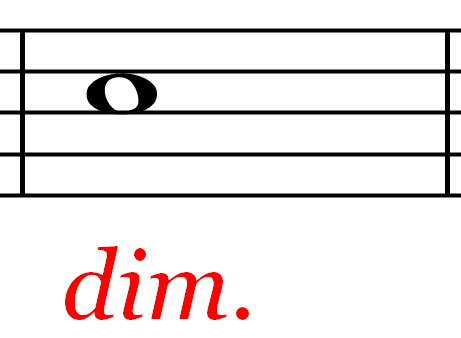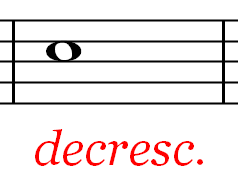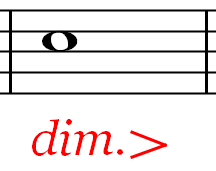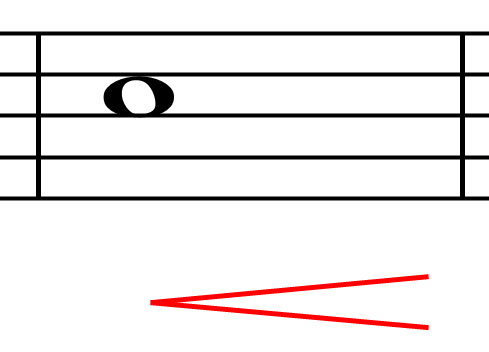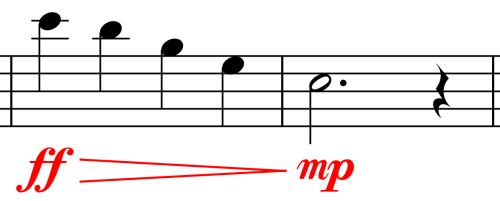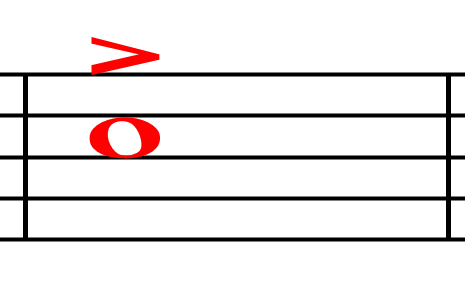Dynamics – Intensity
Scales in Music – A Tonal System
Music Theory Section – Level 2
Dynamics – Intensity
Welcome to Dynamics – Music Theory – Level 2 – Dynamics – Part 21b within the Scales in Music – A Tonal System overall article series.
Overview
In part 21a we discussed several of the symbols and words used to designate dynamics in music theory, music notation and as used in music composition. They were also presented using mp3 sound clips to assist in learning more about them from an experiential standpoint.
In Dynamics – Music Theory – Part 2b we will be furthering our discussion to include additional symbols and tools used to assist the composer in providing other dynamic directions to the performers of the music. This will be done with reference to dynamics symbols and other words which cause a change in the dynamics – intensity of the sound when notating music; crescendo, decrescendo, diminuendo, decrescendo and the use of the hairpin and accent symbols.
Dynamics – Other Symbol Types
Shown below are five other types of markings which provide instructions to the performer using our new symbols and words. Again, their respective descriptions are included. These symbols instruct the performer to alter the intensity or volume of the sound produced on their instrument in specific ways.
Crescendo – The foregoing charts demonstrate the symbols used to instruct the performer to increase loudness over the duration of the note or over a passage or phrase within the composition. The mark for crescendo is in the top chart shown in red. It is placed under the staff as shown.
The symbol is the first four letters of the word crescendo in italics with a period after the second “C” letter. We will be reviewing some alternate ways to notate the crescendo in just a short while.
The second chart above shows the extended crescendo using dots to prolong the gradual increase in intensity of the music.
The third chart shows the crescendo symbol with another symbol called the hairpin which will be explained in more detail below.
All three symbols mean the same, to get louder gradually over the duration of the note, notes or phrase of music.
Diminuendo and Decrescendo
Diminuendo and Decrescendo – The second two symbols are used to instruct the performer to decrease the loudness over the duration of the note, a passage or a phrase. The dim is used for diminuendo whereas the decresc is used for decrescendo. Both mean the same and they are the opposite of the crescendo.
Additionally, each can use the dotted line to extend them just as described above for the crescendo symbols. One of each sample is shown below.
Two Hairpins
It is commonplace to use the crescendo and diminuendo symbols with the hairpin symbol. Placing them is sometimes necessary when you are working with sound samples and notation programs as some of them do not play back properly when using just the cresc, decresc or dim word symbols. There are two commonly used hairpin shapes and three applications for their use.
Crescendo Hairpin – The first hairpin symbol is shown in the chart below. Its shape is two lines of equal length joined together at the left ends of the lines. In music notation, the symbol means the same as crescendo or to get louder gradually.
This symbol instructs the performer to increase the loudness over the duration of the note, notes or phrase of music.
The chart below demonstrates it’s extended use over the duration of a musical phrase. Notice that the lines making up the symbol extend past the measure line causing the continuance of the crescendo to include the dotted half note in the next or following measure.
For the above chart, the performer starts out in the phrase at the volume level equivalent to the mp symbol. The performer gradually increases the volume to ff as shown in measure two.
Please play the mp3 clip of the guitar performing the phrase to hear the effect caused by using these three symbols under the musical phrase. Pay close attention to the loudness level from the mp mark to the ff mark and how the sound increases over the duration of the phrase.
Also please take a little extra time repeating the sound clip until you can easily hear the intensity differences between each quarter note. Notice how each is played a little more loudly than the previous one until the ff volume is reached affecting the dotted half note.
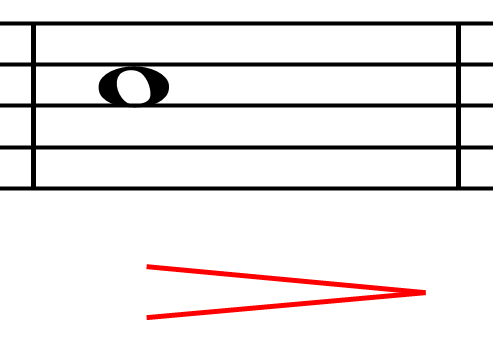 Decrescendo Hairpin – This symbol is also called a hairpin however it instructs the performer to decrease the loudness over the duration of the note, notes or phrase of music.
Decrescendo Hairpin – This symbol is also called a hairpin however it instructs the performer to decrease the loudness over the duration of the note, notes or phrase of music.
This symbol is also made of two lines of equal length but joined on the right ends of the lines. The symbol is placed below the staff.
This next chart shows how the diminishing hairpin and the use of the ff and the mp symbols are used. The mp3 example demonstrates the affect on the phrase using these dynamics marks.
For these marks or symbols the performer begins at the ff volume and gradually decreases the volume to the mp symbol under the dotted half note.
Pay close attention to the loudness level from the ff mark to the mp mark and how the sound decreases in intensity over the duration of the phrase.
 Double Hairpin – This hairpin symbol offers two instructions to the performer. First, is to play the first half of the duration of the note, notes or phrase first increasing its loudness followed by decreasing the loudness over the second half of the total duration of the note, notes or phrase of music.
Double Hairpin – This hairpin symbol offers two instructions to the performer. First, is to play the first half of the duration of the note, notes or phrase first increasing its loudness followed by decreasing the loudness over the second half of the total duration of the note, notes or phrase of music.
Below are three additional examples to demonstrate the use of more than one hairpin when writing music. All of them are variations to those already discussed and shown in the above charts.
Variable Dynamics – With Hairpin – None
This chart shows the use of the double hairpin without the use of other dynamics symbols or words. The mp3 sound clip demonstrates the affect of using these tools for adjusting or altering the intensity of the sounds produced by the performer. The phrase is played smoothly while gradually increasing the intensity and then gradually decreasing the volume.
Variable Dynamics – With Hairpin – fff
The chart above shows another example of how to use both the dynamics symbols and the hairpins to create a variable intensity in the performance of this music. Again, the phrase is played smoothly while increasing and then decreasing the intensity of the music. The mp3 sound clip demonstrates this point.
Variable Dynamics – With Hairpin – p
The above chart also shows using different dynamics symbols and hairpins when notating music. This time the performer is instructed to begin at the fff dynamic, smoothly and gradually decreasing the intensity to the p dynamic and following through by gradually increasing the volume to the fff dynamic. The mp3 sound clip demonstrates this example.
Poco and Molto – With Hairpins
Sometimes you may want to instruct the performers of your music to do something to a smaller or larger degree than they would others play the music. There are two terms which can be used to make further distinctions and for providing these instructions for them.
Poco – Poco is an Italian word meaning “little”. In other words when you create a hairpin for either crescendo or diminuendo you could add the word poco, meaning little or the words poco a poco, meaning little by little.
The performer would then increase or decrease the intensity a small amount rather than that instructed through the use of the word “gradual”. There would be little difference in the loudness if this idea was used however it is performed in such a way that it is a noticeable difference. Here is how this idea is notated in music.
 Poco Crescendo – Increase the Intensity a little bit.
Poco Crescendo – Increase the Intensity a little bit.
 Poco Decrescendo – Decrease the intensity a little bit.
Poco Decrescendo – Decrease the intensity a little bit.
Molto – The second additional symbol used to create even more instructions to the performers of the music you create is the word molto meaning very or much. In other words you would increase or decrease the intensity very much if used with the hairpin or other music dynamic symbols. Here are two notation examples.
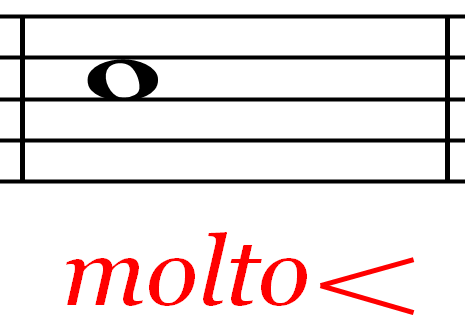 Molto Crescendo – Increase the intensity a lot.
Molto Crescendo – Increase the intensity a lot.
 Molto Decrescendo – Decrease the intensity a lot.
Molto Decrescendo – Decrease the intensity a lot.
These are even more advanced symbols to use when notating music. There are also other methods used to instruct the performers of music as to how to play the notes included in the music. These will be presented in a later article when discussing performance techniques and expressions as used in music notation.
Musical Symbol – Accent
There is however, one more we wanted to include in this article. It is called the Accent Symbol. The chart below shows this symbol in red.
Accent Mark – The accent mark is also used to stress or to cause an increase in intensity of a single note. It can be used to assist in developing a rhythmic pattern based upon the beat in music or used to make a statement when using it infrequently within a composition.
The rhythmic pattern application is shown in this next chart. We have included an mp3 sound clip to give you this additional sensory experience for this music related tool.
The accent symbol can be used on any note, on any beat and on several notes within a musical score. The idea is that this symbol causes the related note to be stressed or slightly increased in volume or intensity when being performed.
Review
As you can tell there are many ways to alter the intensity of music through the use of words and symbols used in music notation. The use of dynamics overall creates for an interesting and attention getting methodology in music composition.
Whether desiring to increase a single note’s dynamics – intensity just a little bit or regulating the intensity of an entire phrase of music, it becomes possible though these symbols and words to do so. The crescendo, decrescendo or diminuendo marking raise and lower, respectively, the intensity of the sound as evidenced through the mp3 sound clips and graphic presentations for the dynamics tools of music composition.
Due to the nature and the number of ways to adjust the volume using these symbols, it is suggested to reference this article for review when you feel you need an additional memory jogger or if you simply wish to review them.
Conclusion
This concludes Dynamics – Music Theory – Level 2 – Part 21b as well as the mini-series on music dynamics. We hope this article has helped you to understand dynamics more thoroughly the ideas of dynamics – intensity than prior to your study of this post.
Next Up
Time plays an important role in music creation. Not simply through the use of various note and rest shapes but also through the use of various time signatures. We have eluded to time signatures in other article and now it is time to review them as well as their use.
Up next is Time Signatures – Music Theory – Level 2 – Part 22a. It is likely to be another mini-series due to the amount of material needing to be covered on this subject matter.
Please proceed to Time Signatures – Music Theory – Level 2 – Part 22.
Additional Reference
Additional information is available on pages 264 and 265 of the Gardner Reed publication titled Music Notation – a Manual of Modern Practice which is highly recommended. Of particular importance to percussion players would be the chart on page 264 demonstrating the marks used by a composer to provide specific instructions for them.
Mini Series Links
To return to the Music Theory – Level 1 directory for the article listings within the series, please proceed to Music Theory Section – Level 1 – Series Introduction – Part 10.
To continue onto Music Theory – Level 2 directory for the article listings within the series, please proceed to Music Theory Section – Level 2 – Series Introduction – Part 20
To proceed to Acoustics of Music directory for the listings within the mini-series, please proceed to Acoustics of Music – Part 1 – Series Introduction.
Note: The music charts were created using the Sibelius Music Notation program. The sound samples were created using Steinberg’s Wavelab and the sound samples are from Soundsonline from East/West.
Dynamics – Intensity


